Sea Change: Food for millions at risk

A remote Indonesian village highlights the threats facing millions of people who depend on marine creatures susceptible to souring seas and ocean warming.
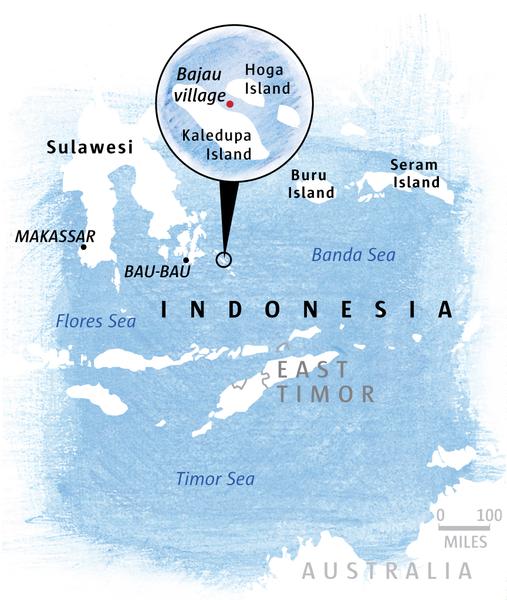
HOGA ISLAND, Indonesia — He sat shirtless on his thin bamboo floor in a home built on posts rising out of the Banda Sea.
Tadi had just returned in his dugout canoe from scanning crevices in a nearby reef for octopus. He and his neighbors spend every day this way — scouring the ocean for something to eat or sell. Fishing, here, is about survival.
Their stilt village has no industry, no land, no running water. They dive without oxygen, wearing hand-carved wooden goggles, and carry spear guns hacked from logs with their machetes. They eat what they catch and sell the rest, using the money to buy everything else they need: boat fuel, root vegetables, rice, wood.
Without fishing, “how would I feed my family?” asked Tadi, who like many Indonesians has only one name.
Now Tadi’s community, like countless others across the globe, is on a collision course with the industrialized world’s fossil-fuel emissions.
Hundreds of millions of people around the world rely on marine life susceptible to warming temperatures and ocean acidification, the souring of seas from carbon dioxide emitted by burning coal, oil and natural gas. That includes Northwest oyster growers and crabbers in the frigid Bering Sea, who now face great uncertainty from shifts in marine chemistry.
But from Africa to Alaska, many coastal communities face a substantially greater risk. These cultures are so thoroughly dependent on marine life threatened by CO2 that a growing body of research suggests their children or grandchildren could struggle to find enough food.
The science of deciphering precisely who might see seafood shortages remains embryonic.
But with many of the most at-risk coastal communities already facing poverty, marine pollution, overfishing and rising seas, the potential for calamity is high.


“I can’t tell you how many people will be affected,” said Sarah Cooley, at Woods Hole Oceanographic Institution in Massachusetts, who studies links between acidification and food security. “But it’s going to be a very big number.”
Said Andreas Andersson, an acidification and coral-reef expert with the Scripps Institution of Oceanography in San Diego: “These people are literally going to be fighting for their lives.”
Among the most vulnerable to changing ocean conditions are people like Tadi and his 1,600 fellow villagers — even if they don’t quite view it that way yet.
Culture built on sea
From his elevated perch sheltered from the midday sun, Tadi could see huts with wispy thatch roofs connected by the rickety planks of his village boardwalk. Everything stood a dozen feet above emerald waters.
Like many in his village, he’s uncertain of his age. But for as long as he can remember, Tadi has netted, trapped, hooked or speared grouper, snapper, wrasses and parrotfish. Sometimes the men in his village disappear to the open sea for days to chase small tuna.
Women swarm the tide flats gathering clams, sea cucumbers, urchins and sea grass. They then paddle to a fish market on nearby Kaledupa Island, where even meaty catches fetch just a few dollars.
Among his peers, Tadi is considered one of the best spear fishermen. And no wonder: He said he stabbed his first fish when he was barely older than a toddler.
That childhood in the ocean left an impression. Every animal seemed huge. Sea life teemed wherever he looked.
“I could choose with my spear whatever fish I want,” Tadi said through a translator. “I never caught any small fish.”

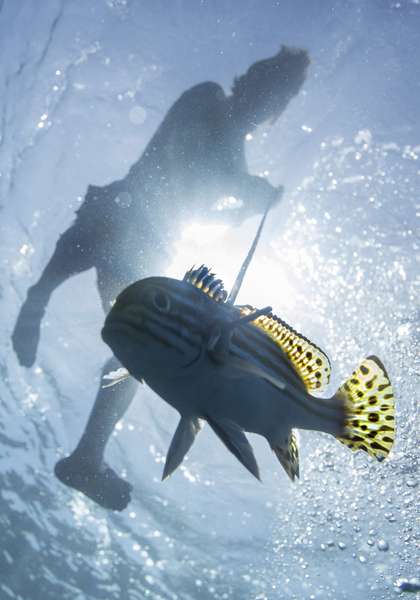
Tadi taught his son, Laoda, to fish this way. Laoda has since taught his son, Adi.
The Sama people, or Bajau, are known as sea gypsies or sea nomads because they once lived mostly on boats. They roamed Southeast Asia between Malaysia, the Philippines and Indonesia, living off the sea, until governments began encouraging them to settle. Tadi’s offshore village was built in the late 1950s.
Today, up to a million sea nomads are sprinkled throughout the Coral Triangle. Their lives are a blend of old ways and new.
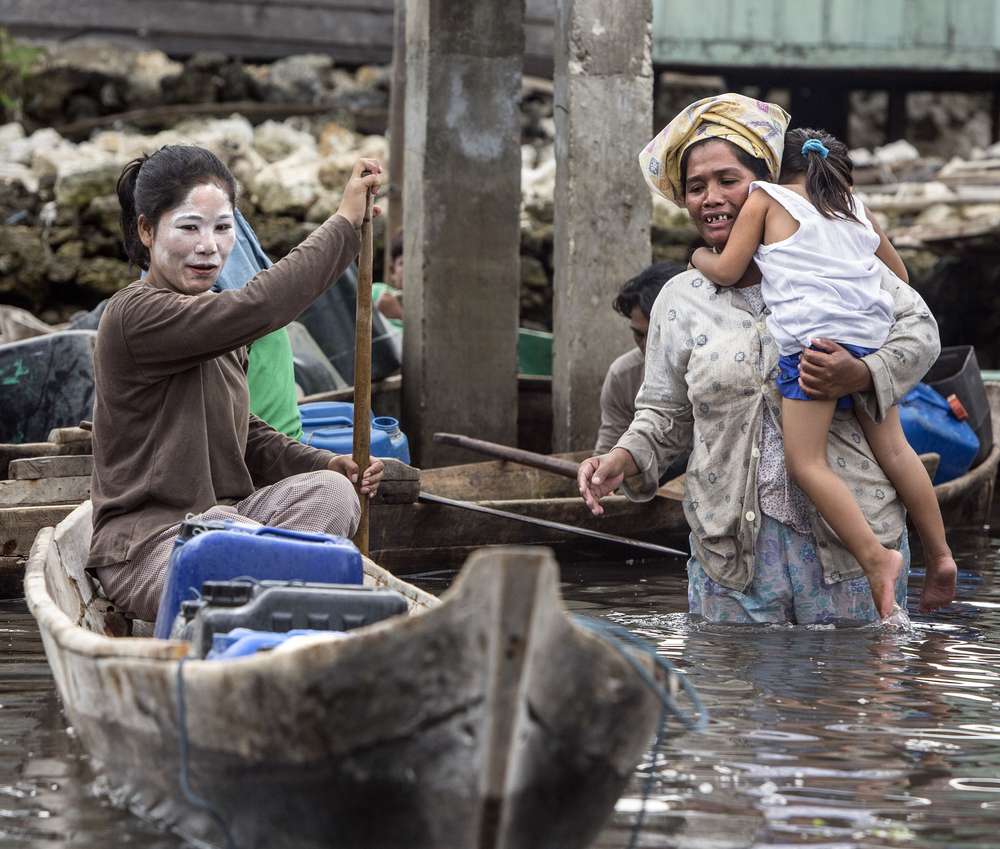
Some divers in Tadi’s village ruptured their eardrums as kids to make equalizing easier. Women dab their faces with rice paste for sunscreen. Villagers stack dead coral for support around the poles that hold their homes. Even fishing weights are sometimes homemade, forged by melting lead in aluminum cans over small open fires and pouring it into wooden molds.
Diesel generators provide electricity a few hours each night, and some residents use it to power televisions. Some fishermen wear expensive dive watches. On a mound of coral rubble beneath one hut is a surprisingly well-maintained billiard table.
After centuries of traveling far and wide, the Bajau’s relocation concentrated their human waste and limited the range of their fishing. This happened just as some in their village adopted the destructive practices of Asia’s worst fishing fleets. A few here fish with coral-destroying bombs or cyanide. Some from the village and nearby islands gather colorful reef fish for sale to the aquarium trade. Commercial trawlers from elsewhere cause more damage. It all takes a toll.
“There’s been a pretty substantial decrease in their catches per amount of effort since the 1990s,” said Paul Simonin, a Cornell University graduate student who has tracked Bajau fishing data.
Tadi’s neighbors and nearby island communities still land plenty of fish, but their reefs have seen better days. Everyone works a bit harder to find food.
And a coming storm from CO2 will only make things worse.
Troubled reefs
Scientists are still navigating the complex ways carbon dioxide can alter the marine world. But some impacts are clear.
Rising temperatures already wreak havoc on corals. Warming waters can cause corals to eject the algae that give them their vibrant color, weakening or killing reefs and turning them white. This process is known as bleaching. Without reductions in global emissions, 90 percent of reefs by midcentury are projected to see severe bleaching episodes every year.
Ocean acidification will just compound the problem.
A quarter of the CO2 spewed by cars and power plants winds up in the ocean. That lowers the pH, makes waters more corrosive and reduces carbonate ions, which then makes it harder for marine creatures to build their shells and skeletons.
Acidification can directly harm animals throughout the food web, from microscopic plankton to some fish. It endangers corals, weakening their skeletons, inhibiting growth, and increasing the likelihood of bleaching. In fact, acidification even accelerates the dissolution and breakdown of the reef.
Join the conversation
Together, souring seas and warming can be worse than the sum of their parts.
“Temperature has zapped a lot of reefs so far, but longer-term effects are likely to come from acidification,” said Charles Sheppard, a professor at England’s University of Warwick who studies climate-change impacts on coral reefs.
These ocean changes may not directly hit the octopus and fish Tadi catches, but will almost certainly rearrange the foods available for those creatures to eat. And loss of coral, by itself, usually translates to fewer fish and marine creatures — often substantially fewer.
Earlier this month, researchers working on reefs naturally bathed in CO2 in Papua New Guinea reported finding half as many small invertebrates — crabs, shrimp, sand dollars, marine worms — as on healthy corals.
“Think about a coral reef as a city, a lot of buildings and houses,” Andersson said. “Without the houses, you have no inhabitants.”

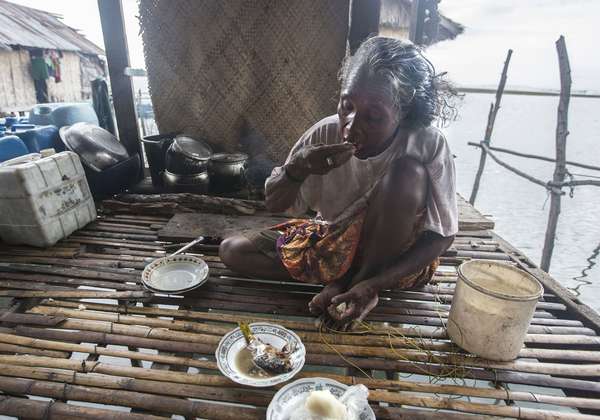
Scientists are still learning how much — or how little — marine life might adapt. Some corals appear more resilient than others, and bleaching doesn’t always ruin healthy reefs, said David Kline, a coral and climate-change scientist at Scripps.
But reefs across Southeast Asia, in particular, already are a fraction of what they once were, according to a 2007 analysis. And reefs taxed by pollution or overfishing are more susceptible to mat-forming algae. In the worst cases, after bleaching, this weedy slime can smother corals for good.
Sheppard has seen how bad things can get. A few years after a 1998 bleaching off Qatar, he went diving on a nearby reef.
Except for weeds, “I didn’t see one other living thing,” he said. “No fish, urchins, starfish, mollusks. Nothing. For acres and acres, it was all dead.”
He likened the stress many reefs face to a person suffering multiple illnesses.
“A bit of temperature rise. A bit of acidification. A bit of overfishing. These things add up,” he said. “If someone has measles and influenza and chickenpox and malaria all at the same time, they’re probably going to die.”
Millions face the threat
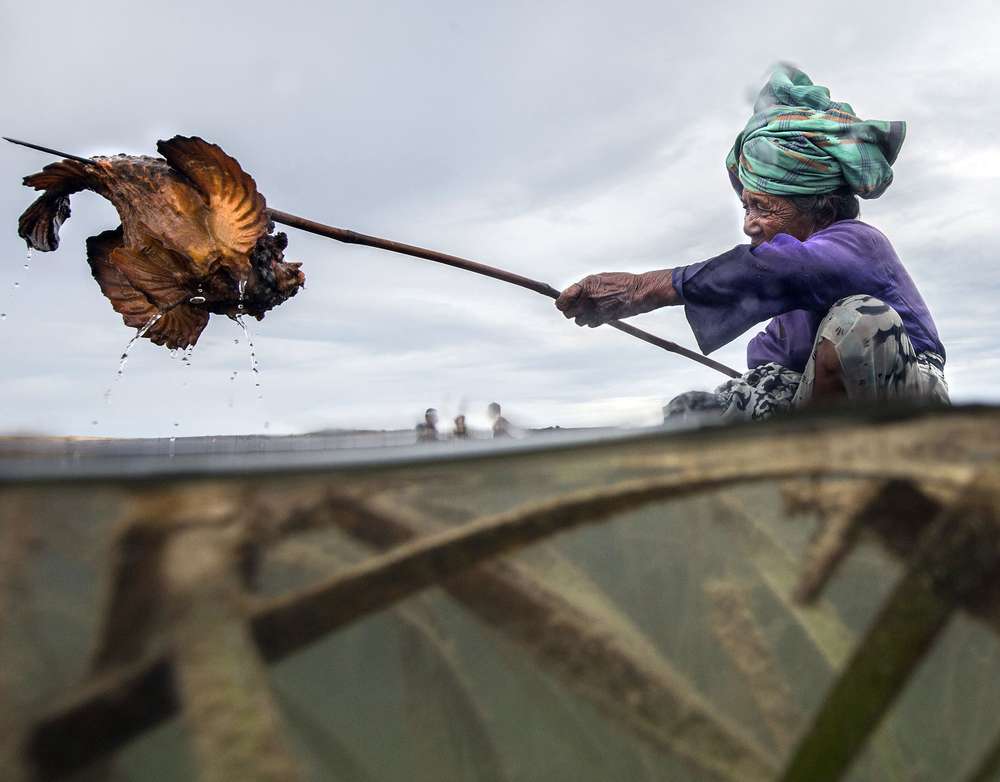
In the grassy shallows a few hundred yards from Tadi’s hut, his neighbor Mbilia sat curled in her canoe, plucking sea urchins from the water and halving them with her machete.
She could not even contemplate a reef with almost no fish. The prospect, to her, seemed amusing.
“I am an old woman,” Mbilia said. “I’m not thinking a lot about that.”
Tadi and Laoda usually don’t think about it much, either. But there are days when fishing is so slow it’s a possibility they just can’t ignore.
“Sometimes we eat everything in one day,” Laoda said. “But if we can’t find anything, we don’t eat.”
Some Bajau don’t believe humans can alter the marine world. Even harder to grasp is the possibility that actions now could cause future decay. For some here, successful fishing is dictated by the whims of testy sea gods.
“They do not see a cause-and-effect relationship the way we do,” said Julian Clifton, a University of Western Australia professor who has studied Tadi’s village. “The Bajau get characterized as backward because they don’t get this idea. But their relationship with time is different from ours. They live in a sort of constant present.”
It’s in part why villagers don’t know their own ages.
If fishing worsens dramatically for Tadi, options appear limited. Fishermen could keep pushing out into the ocean, or the village could fold up and move away, or turn to fish farming. The first might be possible. The second two are much harder.
The Bajau are short on money and clout. They remain among the region’s poorest coastal residents, an ethnic minority often disparaged by others. And by the time they could face real trouble, others around the world may have similar problems, straining resources that otherwise might help.
At least 6 million people in 99 countries fish coral reefs, according to research published in the journal PLOS ONE in June. Another 400 million or more are tied indirectly to coral. Indonesia alone is home to nearly 1,000 inhabited islands, many of which are filled with people who depend on reefs.
Who depends on fish for nutrition
This map shows what percentage of animal protein consumed by residents of each country came from fish in 2008.

Source: Earthtrend database, World Resources Institute, Food and Agriculture Organization of the United Nations
Mark Nowlin / The Seattle Times
“In the 15 or 16 countries we’ve surveyed, 50 to 90 percent of their protein comes from fish,” said Johann Bell, a fish expert helping Pacific Island nations deal with threats to seafood. “It’s a huge problem. There are going to be many who just fall below the radar.”
Some places, like the South Pacific’s Cook Islands, import much of their food, including chicken, mussels, beef, pork and shrimp, with income generated by industries at risk from CO2 — reef fishing, pearl-oyster growing, reef tourism.
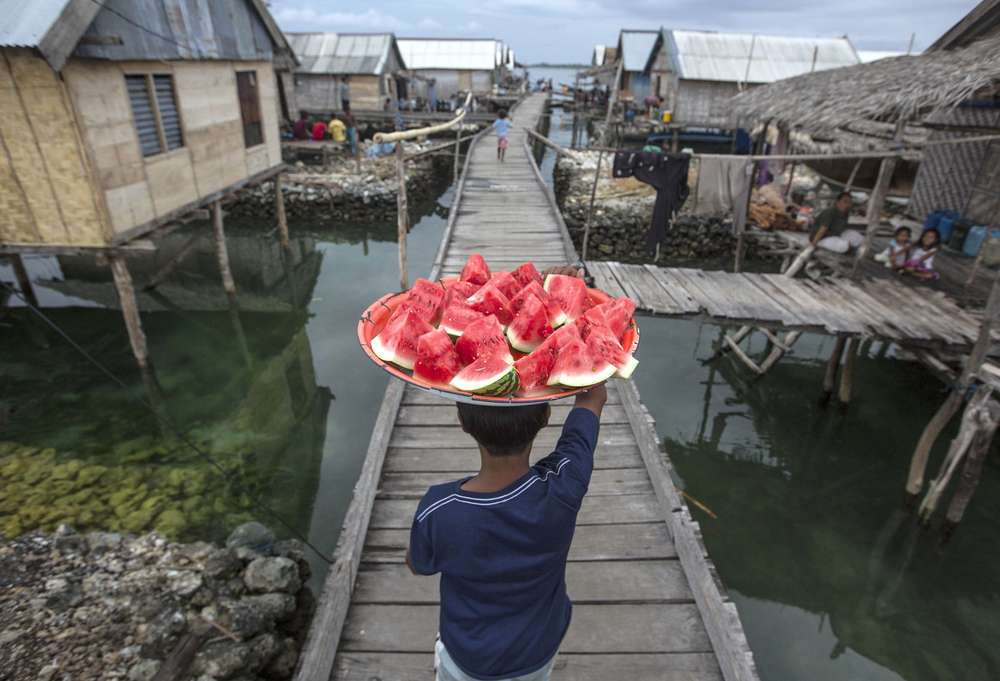
In one village in Tanzania in East Africa, three-quarters of households fish or make their living off troubled reefs, with no other jobs nearby. And most villagers migrated from places with even less work and poorer food options.
“Getting another job would mean starting a farm or setting up a bodega, both of which take a huge upfront investment they don’t have,” said Joshua Cinner, a research fellow with James Cook University in Australia.
Poor vanilla farmers in Madagascar already work several other jobs — yet fish reefs for food and income. In Haiti and Senegal, residents already struggling with malnutrition eat large volumes of wild shellfish, which are particularly threatened by acidification.
Even in southeast Alaska, a few coastal communities are so isolated that subsistence gathering of at-risk clams and crab is essential.
“There may be a grocery store but food is tremendously expensive,” said Cooley, at Woods Hole. “Not everyone has $10 for a can of Spam.”

‘It chills me’
Thirty feet below the sea surface, Tadi’s son, Laoda, inched toward a hefty perch-like reef fish called a sweetlips. He squeezed the spear gun’s trigger. A metal shaft pierced the fish’s scales. Laoda floated up and grabbed a breath.
Some young men in their village already escape to Malaysia to work on ships. Others dream of their children working on land.
Scientists hope growth in fish farming could help remote villages keep hunger at bay. Bell and others are helping subsistence fishermen boost their luck catching tuna and other open-ocean species. A few Bajau villages now farm seaweed for income.
But without CO2 reductions, many see rough seas ahead. Carol Turley, at the United Kingdom’s Plymouth Marine Lab, was among the first to suggest that some coastal people will face starvation risks as a result of warming and acidification. Even now, she said, “it chills me.”
“I keep, keep hoping that I’m wrong about all this, but I don’t think I am,” she said.
For now Tadi and Laoda will keep fishing — and continue not thinking much about the future. That is how Tadi was raised. It’s how he raised Laoda.
Laoda would like his son, Adi, to get an education, so he could try something new if he wishes. But Laoda and Tadi also said it would be OK if Adi stayed a fisherman.
Adi already has shown his grandfather’s talent with a spear gun.

Craig Welch: 206-464-2093 or cwelch@seattletimes.com. On Twitter @craigawelch.
“Sea Change” was produced, in part, with funding from the Pulitzer Center on Crisis Reporting. This article was published December 21, 2013.



Ocean acidification could disrupt marine life on an almost unfathomable scale. What are your thoughts and reactions?
Post a comment →